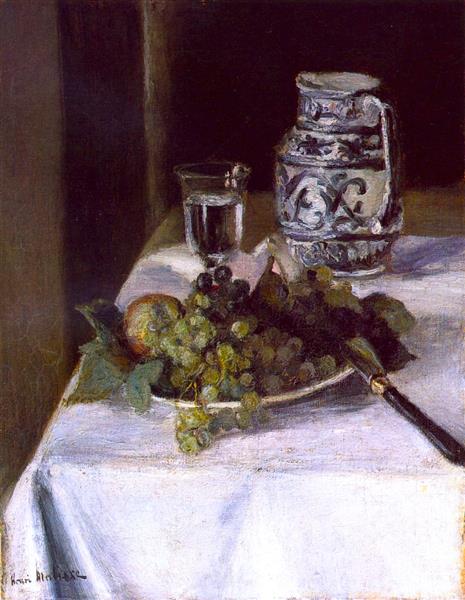Description
A careful visual inspection of the work "Still Life with Grapes" by Henri Matisse, created in 1896, reveals the budding maturity of an artist in search of his own pictorial language. This work, though early in Matisse's career, already shows signs of the mastery that would characterize his later style.
The composition of this still life is a testament to meticulous attention to detail and atmosphere. On a simple table, various elements are arranged: a fruit bowl with clusters of green and purple grapes, a bottle, a porcelain cup, and a bowl with additional fruits. Each object has been outlined with precision and carefully placed, suggesting an organized yet natural symmetry. This order, however, does not dilute the visual richness; rather, it invites the viewer to a leisurely appreciation of each component.
The use of color is moderate but effective. Earth tones and greens predominate. The green grapes, with small touches of light indicating their freshness, contrast with the darker purple grapes, adding depth and dynamism to the whole. The bottle, probably made of dark glass, does not break the harmony and serves as a visual anchor, balancing the composition. The chromatic range, although restricted, gives it a sense of serenity, evoking a domestic and cozy environment.
It is fascinating to observe how Matisse plays with light and shadows to give volume and realism to the represented elements. The soft shadows cast by the objects on the table are not overwhelming but rather accentuate the forms and suggest a natural light source, perhaps a nearby window. This handling of light offers clues about the artist's interest in capturing objective reality, a facet that would transform in his quest for more abstract expression that would characterize his Fauve period.
An important consideration is that there are no human characters in this scene; the "protagonists" are the inanimate objects that fully occupy the pictorial space. This focus on the still life aligns with the tradition of typical 17th-century still lifes, reinterpreted here with a freshness that foreshadows Matisse's stylistic innovations.
When contextualizing this work within Matisse's trajectory, it is impossible not to mention the influences that were shaping his artistic vision. At the time he created "Still Life with Grapes," Matisse was heavily influenced by Impressionism and Realism. It is a period in which the painter is absorbing and experimenting with the techniques of his predecessors but also beginning to question and distort reality as it was perceived then. The precision and naturalism of this early work point to these foundations before Matisse boldly veered towards the use of more saturated colors and simplified compositions that would define his contribution to Fauvism.
In conclusion, "Still Life with Grapes" can be seen not only as a competent still life but as a window into the evolution of one of the greatest masters of modern art. Despite its apparent simplicity, the work resonates with the reflections of a young Matisse, experimenting and perfecting his technique before embarking on the explosions of color and form that transformed painting in the early decades of the 20th century.

